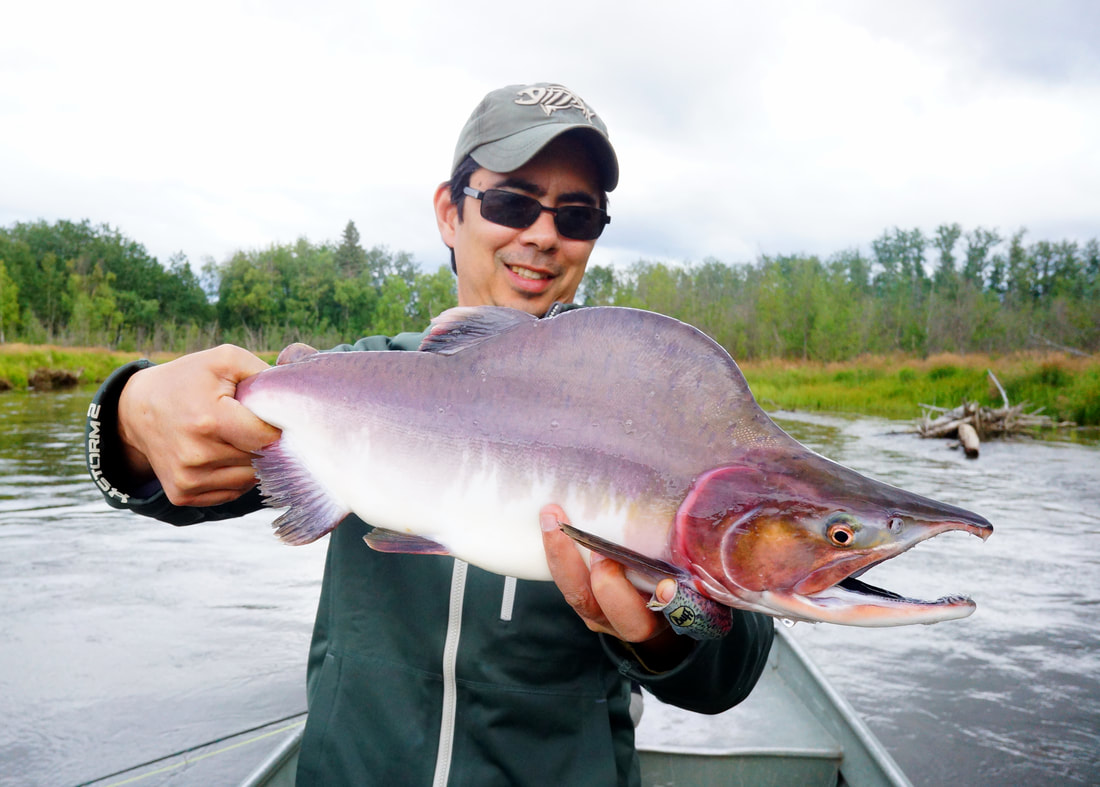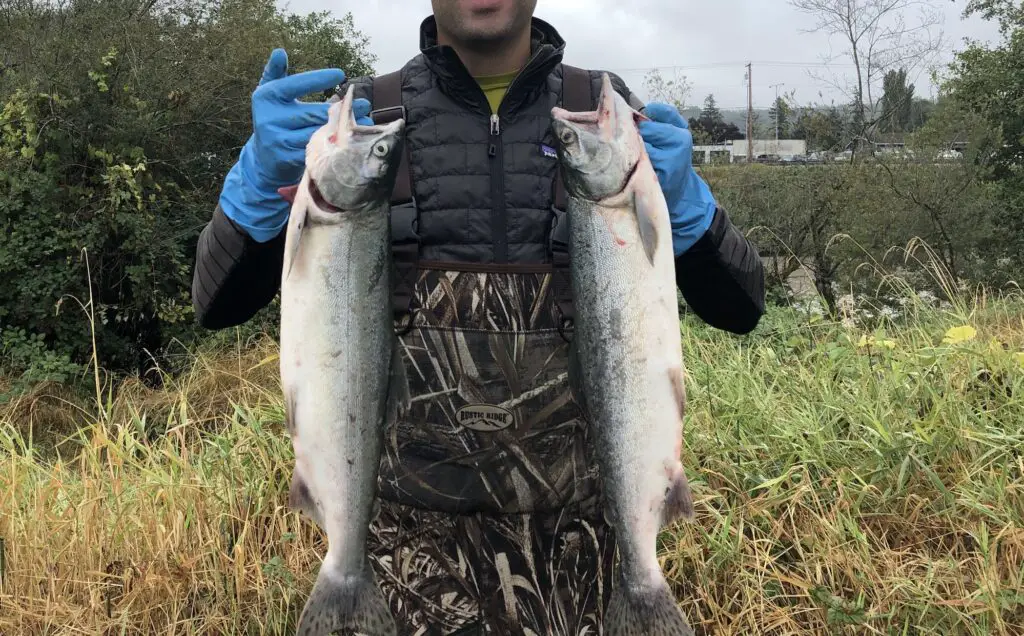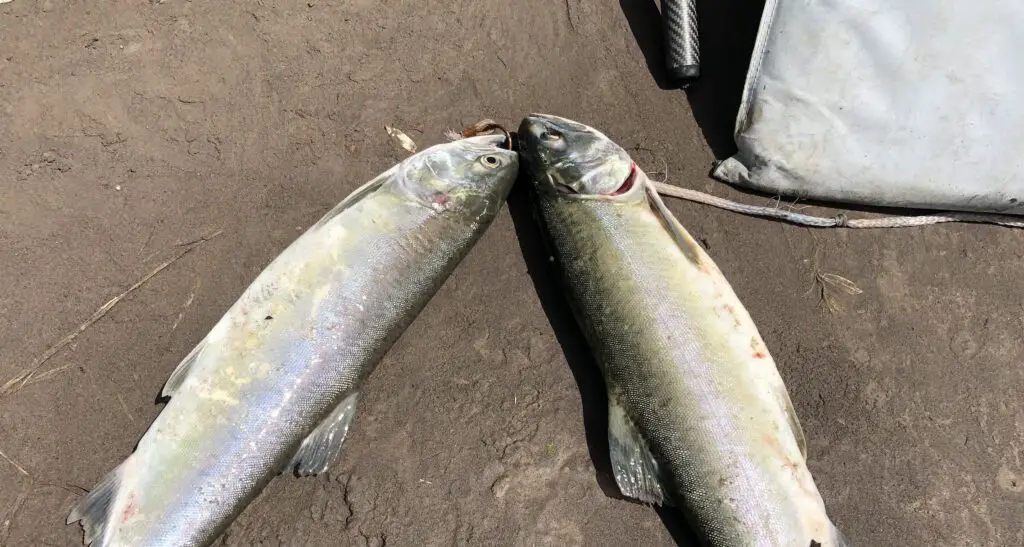Pink salmon, also known as humpies, are one of the most popular and abundant salmon species found in the Pacific Northwest Anglers of all ages and skill levels eagerly await pink salmon runs on odd numbered years. With proper preparation and technique, filling your cooler with these acrobatic fish can be fast and easy This complete guide will teach you everything you need to know about gear, locations, tips and techniques for catching pink salmon.
Pink Salmon Basics
- Pink salmon average 4-8 pounds and get their name from the light pink color of their flesh.
- They have a two year life cycle, returning to spawn on odd numbered years.
- Peak migration happens in late July through September as they move from saltwater to inland rivers.
- Pinks are aggressive biters and will strike lures even when not feeding actively.
- Easy to catch which makes them a great fish for beginning anglers.
Best Fishing Locations
- Puget Sound – Peak action happens late July into August. Fish jump and school near Seattle beaches like Alki, Redondo and Dash Point Park.
- Strait of Juan de Fuca – Pinks start entering in early July. The Sekiu and Port Angeles areas offer good boat access.
- Fraser River, BC – Schools appear in mid August, reaching a crescendo by early September. Check regulations before fishing the tidal and non-tidal sections.
- Rivers – By late August, pinks leave saltwater to push upriver for spawning. Popular rivers include the Puyallup, Green, Snohomish and Skagit.
Gear and Lures
Having the right rod, reel and lures dialed in for pinks will optimize your success
- Rods – Medium power, medium action rods around 8-10 feet work well. Pair with a 2500-4000 sized reel.
- Line – Braid or 15-20 lb monofilament provides good abrasion resistance.
- Lures – Pink is the go to color. Squid, spoons, spinners, jigs and buzz bombs in pink, chartreuse or orange get bit.
- Flies – Pink, orange or chartreuse streamers from size 4-6 entice pinks when fly fishing.
- Drift Fishing – Use a bobber, pencil weight and pink corkies or yarn. Allow rig to drift along bottom.
Pro Tips and Techniques
Follow these expert tips to catch more pink salmon during your trips.
- Fish early morning and evenings when pinks are concentrated near shore.
- Target spots where you see jumping pink salmon busting the surface.
- Troll slowly with pink coyote spoons and squid near shorelines and structure.
- Twitch pink jigs in a lifting and dropping motion when retrieving.
- Use long leaders and light line to detect soft bites when float fishing.
- Keep only bright chrome colored fish for best eating. Release dark fish.
- Bleed and ice fish immediately after catching them.
Fishing Regulations
Before heading out, be sure to consult current regulations for season dates, limits and required licenses. Key things to know:
- Daily limit is typically 4 pink salmon per angler.
- Single point barbless hooks are required when fishing for pinks.
- Anti-snagging rules prohibit setting the hook more than once per cast.
- Retaining only pinks with the hook set in the head/mouth is legal.
- Check for any emergency pink salmon fishing rule changes before each trip.
Family Friendly Fish
Pink salmon are the perfect species for introducing kids to the sport of fishing. Their willingness to bite, smaller size, and nearshore habits make them accessible even for young children. Take your family out and create memories while filling the cooler with delicious fish.

Rigging up for Pink (Humpy) Salmon Fishing
It doesn’t matter what river you are fishing for pink salmon at, having the right setup is important.
Pink salmon are the smallest of the five salmon species, but pound for pound they can put up a great fight.
But just like you don’t take your meat stick trout fishing, leave the heavy stuff at home when it comes to pink salmon fishing.
Why can’t I bring my heavy tackle to the river to catch some stinky pinkies? Well, it’s about 10x the fun if you have properly sized gear.
It’s also always important to match your gear to your technique, but in general, go with a rod/reel / mainline combo that is closer to what you would use for steelhead fishing in the rivers vs salmon.
I cannot go too much further here without recommending this excellent guide to buying a rod for river salmon fishing.
In fact, the first rod/reel mentioned is a perfect setup to get you started with pinks in any river. You can also visit our page dedicated to helping you buy an appropriate fishing reel for salmon or steelhead.
I like to fish for pink salmon with a fishing rod with these ratings: 6-12 lb, 1/4 to 1/2 oz lure weight that is 8’6-9’6 in length.
The rod action will be something like ML for Medium Light, but you can also go lighter and still land these fish (and have lots of fun!).
Fighting a pink salmon in the river on medium-light gear is a lot of fun! You can get away with lighter, but at some point, and especially in combat fishing your fellow angler may get impatient with your “epic battle with a pink salmon on light gear”.
More specifics on rigging up will be covered later on as we discuss each technique that’s appropriate for pink salmon fishing depending on a number of factors.
To aid you on your quest to sustainably fish, hunt, and forage your own food in the PNW

The Pinks are coming! The Pinks are coming! Odd years in the PNW conjure up s of millions of salmon flooding our rivers, enough to get the experienced and novice angler eagerly anticipating the month of August.
We reveal the secrets to success, fishing the best rivers for pink salmon.
I will never forget my first experience fishing for pink salmon in the Puyallup River. It was August and the Pink run that year was epic!
You could almost walk across the river on the pink salmon. I hadn’t even bought a pair of waders yet, but there I was shivering in the glacial melt cold waters of the Puyallup in my jeans and t-shirt.
I had literally no clue what I was doing. I had grown up fishing the lowland lakes of western and eastern Washington for trout and bass, but never salmon and never in the rivers. Yet my brother, my Dad, and I were all catching our limit of pink salmon.
While I could blow right through this topic and arm you with just enough details to get on the river and catch your limit on a good return year…that’s not what we do here at PNWBestLife!
We are going to dive in-depth into this topic in a hopefully reader-friendly way that will enable you to become: *dramatic music*, a master pink salmon angler!
Pink salmon are also known as “Humpies” to many. This is because as the males mature and get closer to spawning they will develop quite pronounced humps. Early on in the season, in the saltwater or near river mouths, pink salmon will be difficult to identify this way.
Humpies / Pink Salmon are the smallest of the five Pacific salmon species that return to North American rivers. And, they have the shortest lifecycle. Every two years a full lifecycle from fry to spawning will take place, which is why the run of pinks occurs every two years.
There are even year pinks as well, but these are far less numerous in Washington.
The BEST Way To Catch PINK SALMON (Complete Setup + Tutorial)
FAQ
How do you fish for pink salmon?
Casting spoons or spinners
Casting and retrieving a spoon or spinner is the most popular angling method. Since pink salmon generally weigh less than six pounds (2.7 kilograms), a light spinning tackle setup is adequate to handle them.
What is the best bait for pink salmon?
Salmon eggs are the top choice for bait, although sand shrimp are very popular for chinook salmon. Some anglers like to fish both at the same time. Marabou jigs (Photo 10) can be used instead of bait and can be especially effective on pink salmon, or other salmon when the water is very low and clear.
Where to fish for pink salmon in Washington state?
Summer and fall salmon fisheries for Chinook, coho, pink salmon and/or chum are popular at sites including Mid-Channel Bank between Point Wilson and Marrowstone Point, Craven Rock, Skunk Bay, Point No Point, Pilot Point and Possession Bar.
Where is the best place to catch pink salmon?
Alaska: Pink salmon are the most abundant Pacific salmon. The Alaska Coho Salmon Assemblage consists of coho salmon, sockeye salmon, pink salmon, and chum salmon throughout southeast Alaska.
What is the best way to catch pink salmon?
Anglers trolling with downriggers or jigging with spoons catch appreciable numbers or pink salmon in the deeper waters of the St. Marys in the weeks before the fish make their way into the rapids. Great Lakes pink salmon eat a variety of fish and other aquatic animals.
What is the difference between pink salmon and other Pacific salmon?
Pink salmon can be distinguished from other Pacific salmon by the large dark oval spots on their back and entire tail fin as well as their general coloring and form. In the sea, pink salmon are steel blue to blue-green on the back, silver on the sides, and white on the belly.
What is the average weight of a pink salmon?
Some people call the resulting fish “chumpys”. Pink salmon are the smallest of the Pacific salmon found in North America weighing on average between 3.5 and 5 pounds, with an average length of 20-25 inches. As with all members of the salmon family, pink salmon are coldwater fish.
Where can you find pink salmon?
Pink salmon are found on both sides of the North Pacific, from Alaska to Puget Sound in Washington State and from Russia to North Korea. In North America, they’re found from the Arctic coast in Alaska and territories in Canada to central California, although they do not reproduce in significant numbers south of Puget Sound.
